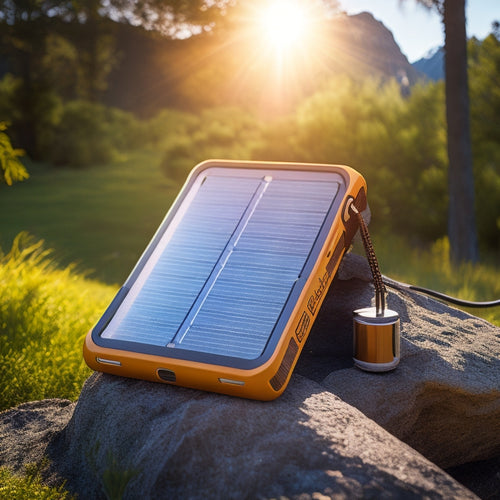
Solar Power Battery Charger
Share
You're investing in a solar power battery charger to utilize the sun's energy and store it for later use, allowing you to access clean power whenever you need it. By integrating a battery charger into your solar panel system, you'll reduce your reliance on traditional energy sources and minimize your environmental impact. To guarantee peak performance, consider your daily energy requirements, the type of battery you need, and the importance of efficient energy storage. High-quality lithium-ion batteries, like the Tesla Powerwall, can provide uninterrupted power during outages and nighttime. Now, investigate the key factors that will help you achieve energy independence and a reduced carbon footprint.
The Essentials
- Solar power battery chargers store excess energy for nighttime or cloudy days, providing uninterrupted power during outages and reducing grid dependence.
- Efficient storage of excess energy generated during the day is essential for reducing energy bills and relies on options like lead-acid and lithium-ion batteries.
- High-quality solar batteries, such as the Tesla Powerwall, optimize energy consumption and empower users with energy independence through on-demand access to clean power.
- Maximum Power Point Tracking (MPPT) technology ensures efficient energy transfer from solar panels to batteries, maximizing energy harvest even under varying conditions.
- Understanding daily energy requirements is essential for determining solar power battery charger capacity, involving the calculation of total watt-hours required by devices.
Renewable Energy on Demand
You're now considering renewable energy on demand, which requires energy storage solutions that can provide clean power availability whenever you need it.
With a reliable electricity supply guaranteed by a Solar Power Backup system, you can enjoy uninterrupted power during outages, keeping your essential appliances and lights running off-grid solar.
This means you'll want to investigate options that can efficiently store excess energy generated by your solar power system during the day for use during the night or on cloudy days.
Energy Storage Solutions
Many renewable energy sources, such as solar and wind power, are intermittent by nature, meaning their output varies depending on weather conditions. As a result, you need an energy storage solution to guarantee a steady supply of power.
Solar power battery chargers offer a reliable way to store excess energy generated during the day for use during the night or on cloudy days. With advanced battery systems, users can alleviate the burden of high energy bills and reduce grid dependence, providing them with greater energy independence and potential cost savings.
Sustainable energy solutions are vital for a reliable energy supply.
When selecting a battery, you'll want to take into account factors like solar efficiency, battery types, and charging speeds. Lead-acid batteries are a cost-effective option, while lithium-ion batteries offer higher efficiency and longer lifetimes.
Installation considerations, such as battery placement and wiring, are also important for peak performance.
Regular maintenance tips, like monitoring battery health and cleaning terminals, can help extend the lifespan of your energy storage system. Conducting a cost analysis will help you determine the most cost-effective solution for your needs.
Additionally, grid integration and environmental impact are essential factors for a sustainable energy system. By understanding market trends and user experiences, you can make informed decisions about your energy storage solution, ultimately achieving greater freedom from the grid.
Clean Power Availability
With the integration of renewable energy sources into the grid, having clean power availability on demand is vital for a smooth shift away from fossil fuels. You're no longer restricted to relying on traditional energy sources, and that's a liberating feeling.
Renewable energy, such as solar energy, allows you to capture the power of nature and store it for later use. This is where battery efficiency comes into play. By investing in a high-quality house solar battery, such as the Tesla Powerwall, you can optimize your energy consumption and reduce your reliance on the grid.
A solar power battery charger guarantees that your stored energy is employed efficiently. You can recharge your batteries whenever the sun is shining, and then use that energy whenever you need it. This on-demand access to clean power gives you the freedom to live life on your own terms.
Imagine being able to power your devices, appliances, or even your entire home without worrying about the environmental impact. With clean power availability, you're no longer tied to the grid, and that's a powerful feeling. You're in control of your energy needs, and that's what freedom is all about.
Zero Energy Waste
You'll want to investigate energy conservation methods that minimize energy waste, ensuring that your solar power battery charger operates at maximum efficiency.
By implementing these methods, you'll reduce your carbon footprint and minimize the environmental impact of your energy usage.
Integrating off grid solar systems and home battery storage(https://www.illchanterl.com) solutions can further optimize your energy harvesting and storage system.
This approach enables you to optimize your energy harvesting and storage system, aligning with the principles of a zero-energy waste philosophy.
Energy Conservation Methods
By incorporating energy conservation methods into your solar power battery charger's design, you can greatly reduce energy waste and maximize its overall efficiency. This is achieved through the implementation of energy-efficient components, such as low-power microcontrollers and high-efficiency power converters.
Additionally, optimizing the charger's operating modes and algorithms can also contribute to energy conservation.
You can further improve energy efficiency by incorporating sustainable practices, such as using recycled materials in the charger's construction and minimizing packaging waste.
Furthermore, designing the charger with modularity in mind can facilitate easy maintenance, repair, and upgrade, thereby reducing electronic waste.
Reducing Carbon Footprint
As energy conservation methods are integrated into the solar power battery charger's design, a natural next step is to focus on reducing carbon footprint. You're not just looking to minimize energy waste, but also to promote sustainable living.
By adopting carbon offset strategies, you can neutralize the emissions produced during the manufacturing and distribution of your solar power battery charger. This means investing in projects that reduce greenhouse gas emissions, such as reforestation, renewable energy, or energy efficiency projects.
Reducing carbon footprint is vital in the pursuit of zero energy waste. You can make a significant impact by choosing materials with low embodied energy, optimizing the charger's design for minimal material usage, and implementing end-of-life recycling programs.
Additionally, consider partnering with suppliers who share your commitment to sustainability. By working together, you can create a more environmentally friendly supply chain.
MPPT Maximizes Energy Harvest
When you're using a solar power battery charger, you want to make certain that every photon of sunlight is converted into usable energy.
With a reliable energy storage solution, such as home battery systems, you can maximize your energy independence.
That's where Maximum Power Point Tracking (MPPT) comes in - it enables efficient energy transfer by continuously monitoring the solar panel's voltage and current output.
Efficient Energy Transfer
Optimizing energy transfer is vital in solar power battery charging, as it directly impacts the overall efficiency of the system. You want to ascertain that the energy generated by your solar panels is transferred to your battery with minimal loss.
This is where Maximum Power Point Tracking (MPPT) technology comes in, allowing you to maximize energy harvest and enhance energy efficiency.
As you investigate solar technology, you'll find that energy efficiency is a critical factor in determining the overall performance of your solar power battery charger.
Optimized Power Output
With Maximum Power Point Tracking (MPPT) technology integrated into your solar power battery charger, you can expect a significant increase in energy harvest. This advanced technology guarantees that your charger operates at the ideal power point, maximizing solar efficiency and reducing energy losses.
As a result, you'll get the most out of your solar panel's potential, even in varying environmental conditions.
MPPT technology continuously monitors and adjusts the charger's operating parameters to match the solar panel's maximum power point. This precise tracking guarantees that your charger extracts the maximum amount of energy from the sun, even during periods of low irradiance or high temperatures.
Furthermore, MPPT technology guarantees seamless battery compatibility, allowing you to charge a wide range of battery types and sizes.
Consider Your Power Needs
You'll need to determine your daily energy requirements to guarantee your solar power battery charger can meet your needs. This involves calculating the total watt-hours your devices require per day, considering factors like usage patterns and device efficiency.
With a reliable renewable energy solution in place, you can maximize energy harvesting and reduce blackouts. You'll also need to select a charger with a required power capacity that can handle your calculated daily energy needs.
Daily Energy Requirements
Calculating your daily energy requirements is an essential step in determining the capacity of your solar power battery charger. To do this, you'll need to assess your energy consumption habits and identify the devices you'll be powering with your solar charger.
Make a list of the devices, their power ratings, and the number of hours you'll use them daily. This will give you a total daily energy requirement in watt-hours (Wh).
Next, consider the solar panel efficiency, which affects the amount of energy your charger can capture from the sun. A higher-efficiency panel will generate more power per hour of sunlight.
You'll need to factor in the average daily sunlight hours in your location to determine the total daily energy input.
Required Power Capacity
Two key factors determine the required power capacity of your solar power battery charger: your daily energy requirements and the capacity of your solar panel.
You've already calculated your daily energy requirements, so now you need to evaluate the capacity of your solar panel. The power rating of your solar panel will dictate how much energy you can generate per day.
When sizing your battery, you'll want to verify it can store the excess energy generated by your solar panel during the day for use at night or on cloudy days. A general rule of thumb is to size your battery to be at least 1-2 times the capacity of your solar panel.
This will guarantee you have enough energy stored to meet your daily needs. For example, if your solar panel has a power rating of 100 watts, you'll want a battery with a capacity of at least 200-400 watt-hours.
Lithium-Ion Battery Durability
You're likely familiar with the importance of a lithium-ion battery's cycle life expectancy, which refers to the number of charge/discharge cycles it can handle before its capacity degrades.
This metric is critical in a solar power battery charger, as it directly impacts the overall system's reliability and longevity.
You'll want to look for a battery that can withstand a high number of cycles, typically measured in hundreds or thousands, to guarantee your charger remains efficient over time.
Cycle Life Expectancy
When it comes to lithium-ion battery durability, one critical aspect to contemplate is cycle life expectancy, which refers to the number of charge and discharge cycles a battery can withstand before its capacity starts to degrade.
You'll want to maximize this lifespan to guarantee your solar power battery charger remains efficient and reliable. Factors affecting cycle life expectancy include charging efficiency, battery maintenance, and operating conditions.
To extend your battery's life, follow proper battery maintenance tips, such as avoiding extreme temperatures, storing the battery in a cool, dry place, and keeping it away from metal objects that can cause shorts.
Additionally, optimize charging efficiency factors, like charging your battery when it's between 20% and 80% full, as this helps reduce wear and tear.
By doing so, you can expect a typical lithium-ion battery to last around 300 to 500 charge cycles, with some high-quality batteries exceeding 1,000 cycles.
Frequently Asked Questions
Can I Use a Solar Power Battery Charger With a Lead-Acid Battery?
You can recharge your lead-acid battery with a solar charger, but it's essential to monitor maintenance and guarantee the charger's solar efficiency aligns with your battery's specific needs to prevent damage and optimize performance.
How Do I Clean the Solar Panels for Optimal Performance?
You'll be astonished by the grime that's suffocating your solar panels! Regular panel maintenance is essential, so grab a soft brush, mild soap, and distilled water to gently scrub away dirt and debris, ensuring maximum energy harvesting with expert cleaning techniques.
Is a Solar Power Battery Charger Compatible With My Device?
When checking compatibility, you'll want to take into account device specifications, such as voltage, current, and connector type. Verify the charger's output matches your device's input requirements; then, you can enjoy hassle-free, off-grid power, unshackled from constraints.
Can I Charge My Battery While It's Still in Use?
When using your device, you're wondering if you can simultaneously charge its battery. Yes, you can, but be aware that this practice, called "opportunistic charging," might reduce battery lifespan and charging efficiency over time.
Are Solar Power Battery Chargers Weather-Resistant?
When venturing outdoors, you'll want gear that can withstand the elements; look for chargers with weather-resistant designs, durable solar panel materials, and IP67 ratings to guarantee your freedom isn't hindered by a little rain or dust.
Final Thoughts
As you utilize the power of the sun, your solar power battery charger works tirelessly to store energy for your needs. With maximum energy harvest and zero waste, you're in control of your renewable energy supply. Durable lithium-ion batteries stand ready, backed by MPPT technology that optimizes every charge. Your power needs are met with precision, ensuring a reliable and efficient flow of energy on demand.
Related Posts
-

Why Outdoor Solar Lighting Systems Are Sustainable
Outdoor solar lighting systems are sustainable because they utilize renewable energy, drastically reducing your carbo...
-

Diy Off Grid Solar
By embracing DIY off-grid solar, you can break free from grid dependence, slashing your energy bills by up to 90% and...
-

Fastest Solar Chargers for Emergency Power
When choosing the fastest solar chargers for emergency power, you need to focus on features like rapid charging capab...


